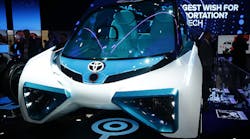Elon Musk may think hydrogen-powered vehicles are rubbish, but Toyota Motor Corp. and a cadre of Japan’s leading manufacturers are betting otherwise -and not just on cars.
With the blessing of Prime Minister Shinzo Abe, Toyota is at the forefront of Japan’s efforts to use hydrogen and fuel cells to power cars, heat homes and keep factories running. Other companies pursuing the technology include Panasonic Corp., Toshiba Corp. and JX Nippon Oil & Energy Corp.
Japan’s enthusiasm for hydrogen contrasts with growing momentum toward electric cars in the U.S. and Europe, where automakers from Volkswagen AG to General Motors Co. are working on dozens of models due to be released in the next few years. It’s one of the few ways the nation can both cut emissions and its reliance on imported fuels as it winds down nuclear power following the meltdown at Fukushima.
“It’s about increasing the number of players and putting in place hydrogen infrastructure in the most appropriate locations so that hydrogen business becomes viable in 10 to 15 years,” said Taiyo Kawai, project general manager at Toyota’s R&D and Engineering Management Division.
Fuel cells convert hydrogen into electricity, leaving only water vapor as a byproduct. They’ve been in use for decades and gained prominence when the U.S. space program took off in the 1950s. It’s only in the last few years that they’ve become cheap enough for more widespread commercial applications. Sourcing and handling the hydrogen for them remains one of the biggest logistical and economical challenges.
Japan’s drive to use the lightest element is running alongside its incentives for electric vehicles, though the nation has done more than any other to establish fuel cells as a viable technology for power generation and maybe cars as well.
One catalyst is the Tokyo Olympic Games in 2020, a major showcase for Japan’s technological prowess. The capital has announced plans to spend 45.2 billion yen ($400 million) on fuel-cell vehicle subsidies and hydrogen stations by the time of the games. Toyota envisions more than 100 fuel-cell buses crisscrossing the nation’s capital by then.
Prime Minister Abe has become a vocal advocate for hydrogen -- both to stimulate developments in technology and to help the resource-poor nation lower greenhouse gases. With Japan relying more on fossil fuels since the shuttering of most of its nuclear reactors after the Fukushima disaster almost six years ago, it’s a push that’s gained more urgency.
“Hydrogen energy is an ace in the hole for energy security and measures against global warming,” Abe said in a speech to parliament on Jan. 20. “Thanks to deregulation, a hydrogen society of the future is about to begin here in Japan.”
Examples of projects under development include:
- Toyota has been selling a fuel-cell vehicle called the Mirai since late 2014 and targets annual global sales of 30,000 hydrogen vehicles by 2020.
- GM and Honda Motor Co. plan to begin jointly making fuel-cell systems around 2020.
- The Japanese government is targeting 1.4 million installations of “ene-farm” residential fuel-cells by 2020 and 5.3 million by 2030.
- Toshiba is offering products called H2One, which combine a storage battery and fuel cell in a container. It’s designed for sites with bigger energy demand and can be used in disasters. One such project in Kawasaki, near Tokyo, can supply enough electricity and hot water for 300 people for a week.
- The government aims to be producing hydrogen from emissions-free sources by 2040.
- Kawasaki Heavy Industries Ltd. and Iwatani Corp. are among companies developing technologies to produce hydrogen through the gasification of lignite coal and studying how to ship liquefied hydrogen in the western city of Kobe.
While Japan’s program is global in reach, envisioning liquid hydrogen supplies coming from the U.S. and Australia, the projects in most other places envision the fuel being produced and consumed locally, said Ali Izadi-Najafabadi, an Tokyo-based analyst for Bloomberg New Energy Finance.
Even so, for all the promise offered by fuel cells in homes and cars, widespread use of hydrogen would require setting up supply chains and costly infrastructure such as filling stations from scratch. For that reason, Musk, the founder of Tesla Inc., has famously scorned hydrogen vehicles as expensive and impractical, particularly since lithium-ion batteries that power his own cars are already widely available.
“Electric vehicles are obviously cheaper,” said Hiroyuki Sato, a consultant at Nomura Research Institute. “There are charging stations, and they are being mass produced.”
Energy Mix
Even with Abe’s backing, hydrogen isn’t expected to play a dominant role as a source of energy in Japan any time soon. The nation’s 2030 power mix, an outlook published by the trade ministry in 2015, makes no mention of hydrogen.
The industry’s value worldwide is forecast to grow by 46 times in the next 15 years to 4.9 trillion yen ($44 billion) from about 106 billion in the year through March 2016, according to Fuji Keizai Co., a Tokyo-based research company.
“We are aware that we need to reduce costs in order not to rely on subsidies,” said Katsuyuki Sasaki, head of the hydrogen business promotion department at JX Nippon Oil & Energy, which has set up 39 FCV filling stations in Japan. “We are working on packaging and standardizing stations.”




